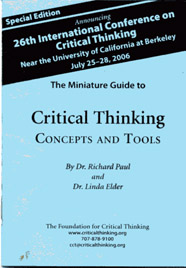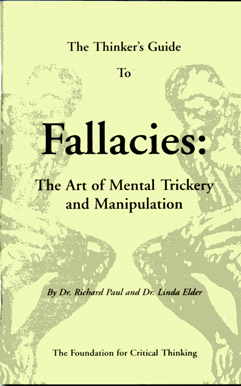One of the first things that happens when you get a faculty mailbox in a philosophy department is that unsolicited items start appearing in it. There are the late student papers, the book catalogs, the religious tracts — and occasionally, actual books that, it is hoped, you will like well enough that you will exhort all your students to buy them (perhaps by requiring them for your classes).
Today, I’m going to give you my review of two little books that appeared in my faculty mailbox, both from The Foundation for Critical Thinking. The first is The Miniature Guide to Critical Thinking Concepts and Tools, the second The Thinker’s Guide to Fallacies: The Art of Mental Trickery and Manipulation, both written by Richard Paul and Linda Elder.

The Miniature Guide to Critical Thinking Concepts and Tools is a very little booklet — 20 pages of content on pages that are 4″ by 5.5″. (The font size, in places, is correspondingly small, so you’re well-advised to have your reading glasses handy.) The booklet itself describes critical thinking in terms of “elements of thought” (such as purpose, question at issue, information, interpretation and inference, assumptions, and point of view) and offers the reader different ways to identify these elements in her own reasoning or in the reasoning of others. For example, pp. 6-7 offer “A Checklist for Reasoning”, which includes items like:
- State your purpose clearly.
- Distinguish questions that have definite answers from those that are a matter of opinion and from those that rerquire consideration of multiple viewpoints.
- Clearly identify your assumptions and determine whether they are justifiable.
- Infer only what the evidence implies.
On p. 8, we find “Questions Using the Elements of Thought” which the reader is encouraged to ask himself as he is engaged in writing a paper, participating in an activity, or completing a reading assignment. On p. 13, these elements are the basis of a “Template for Analyzing the Logic of an Article”, and on p. 14 they reappear in “Criteria for Evaluating Reasoning”.
This degree of repetition might be frustrating to the professional academic. Indeed, were a student to read the whole booklet from start to finish, by page 10 she might well be shouting, “I get it already!” However, it’s pretty clear that this booklet is intended to be used as a pocket reference for students. For that reason, presenting multiple “tools” with which to examine the structure of a piece of reasoning — whether a template to ask questions about an article you’re reading for class, or a set of questions to ask yourself as you try to revise your own essay — seems like a successful strategy. The authors have also used diagrams and charts to present these ideas in ways that may be helpful for visual learners.
The authors also suggest, without belaboring the point, that a certain kind of reflection about how we are thinking (i.e., how clearly, how thoroughly, with what kind of evidential support or serious consideration of possible objections, etc.) is essential — not just when one is learning how to be a good critical thinker, but even when one is a “master thinker”. They seem to be advocating a view that good critical thinking is the result of the careful cultivation of good habits of mind. It’s hard view for a teacher not to like.
All in all, this seems like a good resource for students, one that is not only useful but has a high probability of actually being used. Single copies of the booklet are priced at $4.00 (plus shipping and handling), which seems a little steep to me, but bought in quantities of 25-199, the price per booklet drops to $2.00.

The Thinker’s Guide to Fallacies: The Art of Mental Trickery and Manipulation is a more substantial booklet, (5″ by 8″, 56 pages). Here, the specific critical thinking focus is upon identifying patterns of reasoning that should not be persuasive because they don’t actually provide logical support for the conclusions being advanced. That there are many such bad patterns of reasoning likely contributes to the greater length of this booklet.
The book starts by considering some main sources of fallacious reasoning, faulty generalizations and reasoning from analogy, examining a good range of examples to illuminate where the logical problems are and why we might be persuaded. Then, it appeals to the competitive streak in its reader by detailing “44 Foul Ways to WIn an Argument”. Of course, the reader is discouraged from actually using any of the enumerated “dirty tricks” to frame an argument, but is encouraged to recognize them in the arguments of others:
If you want to become aware of how politicians, the news media, the advertising industry, public relations experts, government officials and assorted friends and enemies use the arts of manipulation and con artistry against you — enter their point of view! Learn the art of intellectual dirty tricks so that, if necessary, you can out-think the tricksters. (p. 19)
Following the laundry list of dirty tricks, the booklet presents fertile ground for hunting for examples of such fallacies at work: three political speeches (one by Albert J. Beveridge in 1897, one by George W. Bush in 2004, and one by Ralph Nader in 2000).
Students will likely be engaged by this approach to examining arguments for logical shortcomings. But I found the presentation here offputting. It’s not so much that students might try to master the dirty tricks to find success in politics, the news media, public relations, etc. The authors try to head this off by distinguishing between people who commit fallacies because they don’t reason clearly enough to know any better and the “skilled manipulators”:
Manipulators do not use their intelligence for the public good. Rather they use it to get what they want in alliance with those who share their vested interests. Manipulation, domination, demagoguery, and control are their tools. (p. 5)
The “skilled manipulators are contrasted with the “fair-minded critical persons”, making it pretty clear which set of commitments the authors think is preferable. However, the booklet doesn’t really give a full-blown argument for why one ought to prefer fairness and serving the public good over manipulation of others to serve one’s own self-interest. I agree with their conclusion, but if I were an 18 year old who had read a lot of Ayn Rand, it’s not clear that they would be able to persuade me. In a book about what a good critical thinker should, and should not, find persuasive, this is a shortcoming.
Indeed, a close reading of the book reveals a fair number of strong assertions crying out for evidential support. For example:
The human mind is often myopic, inflexible, and conformist, while at the same time highly skilled in self-deception and rationalization. People are by nature highly egocentric, highly sociocentric, and wantonly self-interested. Their goal is not truth but advantage. They have not acquired their beliefs through a rational process. They are highly resistant to rational critique. Blind faith, fear, prejudice, and self-interest are primary organizers of much human thinking. Self-delusion, in conjunction with lack of self-command, characterize much human thinking. A highly compromised integrity is the result. If you point out a mistake in thinking to most persons, you may silence them momentarily. But most, like rubber bands that have momentarily been stretched and let go, will soon revert to whatever it was they believed in the first place. (p. 7)
It would be nice to see some references here to support these bold proclamations about human nature; none are given. So … is the reader supposed to just accept these assertions, perhaps on the basis of the authority of the authors (identified on the front cover as Dr. Richard Paul and Dr. Linda Elder)? Is this a crypto-exercise-for-the-reader in critical thinking?
A little voice in me worries that it’s not, given the sentences that follow:
It is for this reason that cultivation of intellectual virtues is so crucial to human development. Without a long-term transformation of the mind, little can be done to produce deeply honest thought. (p. 8)
I’m the first to agree that mental muscles ought to get regular exercise. But, you see, The Foundation for Critical Thinking is selling intellectual cultivation. Seriously, check out the fees for their upcoming conference. Ouch! You can come by intellectual cultivation a lot cheaper at your public library, or on the internets (for example, by reading Orac or the Skeptics’ Circle). In fact, there’s a nice web “Fallacy File”, and Google helped me instantly locate the story that introduced me to several classic fallacies when I saw it performed as a monologue in the talent show at **cough** math camp.
The Thinker’s Guide to Fallacies: The Art of Mental Trickery and Manipulation is $6.00 (plus shipping and handling) for individual copies, $4.00 each if you’re buying 25-199 of them. In terms of value per dollar, I suspect it’s a better deal than the conference, but I have limited facts with which to back up that assertion.

Thank you for the reviews: personally, I would like to see more of this kind of “meta-analysis” of critical thinking in general and the literature specifically (especially if you do the work for me!). I think a lot of the bloggers here tend to get bogged down in the minutae of their own areas of expertise when a more general (philosophical) analysis would reveal simple inadequacies in thinking.
However, the booklet doesn’t really give a full-blown argument for why one ought to prefer fairness and serving the public good over manipulation of others to serve one’s own self-interest.
I think you’re conflating two issues here – means and motive. I agree that it’d be good to discuss the motives involved a bit, but that might be getting a little off track for a critical thinking guide.
An open question: is it morally acceptable to use manipulative techniques in a good cause?
Thanks for the thoughtful reviews.
I’ve long thought that it would be well worthwhile to teach critical thinking (as well as sound scientific method), preferably as a prerequisite for college/university admission. Questions that arise are how early can this be taught effectively, and in what context(s) can it be brought into a normal curriculum. Obviously, the best approach would be to teach the basics and then demonstrate their applicability in every course possible.
If one is going to teach “values,” I’d certainly think that critical thinking should be right at the top of the list.
Wednesday Hodgepodge
The evidence continues to mount that the Republican party's single goal is the accumulation of power by any means, legal or illegal: The latest sign that Republicans have an election-year strategy to shut down voter registration drives comes f…
Pers’nly, the preachy stuff about not abusing argument puts me off – heavy-handed moralizing is just off-putting, even patronizing. Machiavelli denounced manipulativeness far more effectively through appearing to do precisely the opposite…